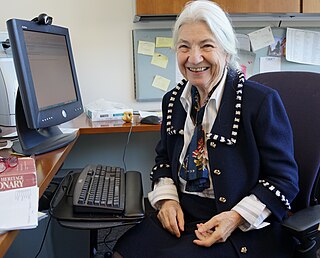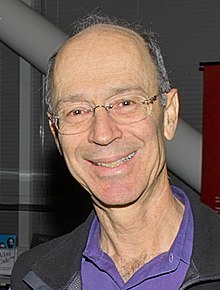
SRI International (SRI) is an American nonprofit scientific research institute and organization headquartered in Menlo Park, California. The trustees of Stanford University established SRI in 1946 as a center of innovation to support economic development in the region.
Robert M. Haralick is Distinguished Professor in Computer Science at Graduate Center of the City University of New York (CUNY). Haralick is one of the leading figures in computer vision, pattern recognition, and image analysis. He is a Fellow of the Institute of Electrical and Electronics Engineers (IEEE) and a Fellow and past president of the International Association for Pattern Recognition. Professor Haralick is the King-Sun Fu Prize winner of 2016, "for contributions in image analysis, including remote sensing, texture analysis, mathematical morphology, consistent labeling, and system performance evaluation".

Shakey the Robot was the first general-purpose mobile robot able to reason about its own actions. While other robots would have to be instructed on each individual step of completing a larger task, Shakey could analyze commands and break them down into basic chunks by itself.

Thomas M. Cover [ˈkoʊvər] was an American information theorist and professor jointly in the Departments of Electrical Engineering and Statistics at Stanford University. He devoted almost his entire career to developing the relationship between information theory and statistics.

Nils John Nilsson was an American computer scientist. He was one of the founding researchers in the discipline of artificial intelligence. He was the first Kumagai Professor of Engineering in computer science at Stanford University from 1991 until his retirement. He is particularly known for his contributions to search, planning, knowledge representation, and robotics.
Leslie Pack Kaelbling is an American roboticist and the Panasonic Professor of Computer Science and Engineering at the Massachusetts Institute of Technology. She is widely recognized for adapting partially observable Markov decision processes from operations research for application in artificial intelligence and robotics. Kaelbling received the IJCAI Computers and Thought Award in 1997 for applying reinforcement learning to embedded control systems and developing programming tools for robot navigation. In 2000, she was elected as a Fellow of the Association for the Advancement of Artificial Intelligence.

John F. Canny is an Australian computer scientist, and Paul E Jacobs and Stacy Jacobs Distinguished Professor of Engineering in the Computer Science Department of the University of California, Berkeley. He has made significant contributions in various areas of computer science and mathematics, including artificial intelligence, robotics, computer graphics, human-computer interaction, computer security, computational algebra, and computational geometry.
Richard O. Duda is Professor Emeritus of Electrical Engineering at San Jose State University renowned for his work on sound localization and pattern recognition. He lives in Menlo Park, California.

Ruzena Bajcsy is an American engineer and computer scientist who specializes in robotics. She is professor of electrical engineering and computer sciences at the University of California, Berkeley, where she is also director emerita of CITRIS.
Matti Kalevi Pietikäinen is a computer scientist. He is currently Professor (emer.) in the Center for Machine Vision and Signal Analysis, University of Oulu, Finland. His research interests are in texture-based computer vision, face analysis, affective computing, biometrics, and vision-based perceptual interfaces. He was Director of the Center for Machine Vision Research, and Scientific Director of Infotech Oulu.
David Randolph Brown was an American computer scientist. He was a member of the Massachusetts Institute of Technology leadership team that created Project Whirlwind, "one of the first large-scale, high-speed computers".
The following outline is provided as an overview of and topical guide to machine learning:
Dorin Comaniciu is a Romanian-American computer scientist. He is the Senior Vice President of Artificial Intelligence and Digital Innovation at Siemens Healthcare.

David S. Doermann is an American computer science researcher and professor in the areas of document analysis, computer vision, and artificial intelligence.

Gang Hua is a Chinese-American computer scientist who specializes in the field of computer vision and pattern recognition. He is an IEEE Fellow, IAPR Fellow and ACM Distinguished Scientist. He is a key contributor to Microsoft's Facial Recognition technologies.

Gregory D. Hager is the Mandell Bellmore Professor of Computer Science and founding director of the Johns Hopkins Malone Center for Engineering in Healthcare at Johns Hopkins University.

David G. Stork is a scientist and author, who has made contributions to machine learning, pattern recognition, computer vision, artificial intelligence, computational optics, image analysis of fine art, and related fields.

Helen Chan Wolf is an artificial intelligence pioneer who worked on facial recognition technology and Shakey the robot, the world's first autonomous robot, at SRI International.

Rita Cucchiara is an Italian electrical and computer engineer, and professor in Computer engineering and Science in the Enzo Ferrari Department of Engineering at the University of Modena and Reggio Emilia (UNIMORE) in Italy. She helds the courses of “Computer Architecture” and “Computer Vision and Cognitive Systems”. Cucchiara's research work focuses on artificial intelligence, specifically deep network technologies and computer vision for human behavior understanding (HBU) and visual, language and multimodal generative AI. She is the scientific coordinator of the AImage Lab at UNIMORE and is director of the Artificial Intelligence Research and Innovation Center (AIRI) as well as the ELLIS Unit at Modena. She was founder and director from 2018 to 2021 of the Italian National Lab of Artificial Intelligence and intelligent systems AIIS of CINI. Cucchiara was also president of the CVPL from 2016 to 2018. Rita Cucchiara is IAPR Fellow since 2006 and ELLIS Fellow since 2020.












